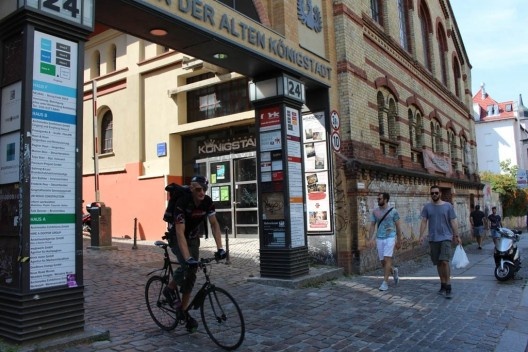
Entrada do centro de indústrias criativas on o LAVA Berlin está instalado [Foto divulgação]
GC: Can you talk about your experience at UNStudio and how it has contributed to your work in visionary architecture and the use of new technologies in architecture?
TW: When I graduated from Columbia I wanted to combine two things. One was the experience I had gained in the paperless studios with the digital tools and also the practical work that I had gained when I had worked as an intern for two years after graduating in Germany. So UNStudio was a place where I could combine the two. There was a lot of work going on in the Netherlands at that time at the end of the 1990s and beginning of 2000s. When I started that it was an amazing time when UNStudio became an internationally renowned office, with more international people educated in the AA or in Columbia. We worked in international competitions and we were introducing digital tools. And it was an amazing time when we could freely develop new ideas, the big details, smoothness, the organization of space and organization of matter in space. We combined the academic approach with the knowledge and the possibility and the optimism of implementing ideas from the computer to the construction site.
GC: Does the experience at UNStudio still influence your teaching?
TW: Yes, of course the work with diagrams and the abstract. Decontextualizing and then recontextualizing certain information. Trying to work with the main connections between two thing, what Ben and Caroline called invisible forces, that has influenced my teaching. And with the digital tools you can visualize otherwise invisible forces, even if it just gives you an idea of how something could be done rather than just being a thought. Certain ideas just go beyond our own imagination. We can produce diagrams to trigger our imagination, see other ways in which certain things can be described. Then we come to a problem that is solvable from a technical level.
GC: Regarding the work that you guys do here at the LAVA studio in Berlin. Why is the studio spread out in three separate offices (in Stuttgart, Berlin and Sydney)?
TW: The office started in Stuttgart because Alexander was living there but I lived in Amsterdam. But for family reasons I moved to Berlin. There is a lot of work in Berlin and there is freedom in doing certain things. And my teaching position in Stuttgart initially was for only 6 years. Berlin is quite an international hub, which has a lot of startups and lot of creative people. The idea was to have one office in Stuttgart, which is the German Silicon valley, where you have a lot of high technology and small scale manufacturing companies producing intelligent machines and working with these tools, combining that with the Berlin office, which has an international culture. And since I teach in Stuttgart I can be in both offices every week. With the office in Sydney we need some sort of digital communication.
GC: Do you develop projects together with the other offices?
TW: At the beginning we had the big projects in Abu Dhabi in which we all worked together. Smaller projects we do locally, but larger projects we do together. We need to have a certain size for each office to make it sustainable. Sometimes a smaller scale is better because you know better all the people, in the office and has more direct involvement in what is going on. At the moment we have four projects in Berlin, but we are also doing international projects here. For example we participate in some projects in China with the Sydney office as an international consortium. We are still testing different approaches. The idea is to do the larger projects together taking advantage of the different capacities and experiences that Chris, Alexander and I have. We are regularly involved in discussions about these larger projects. We have a Friday report at the office. Every Friday we put a couple of pages for every project on the server so everyone knows what need to be done for each project and we discuss about them.



